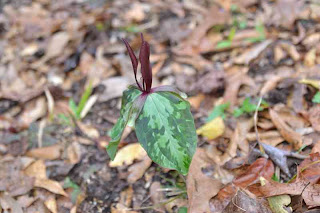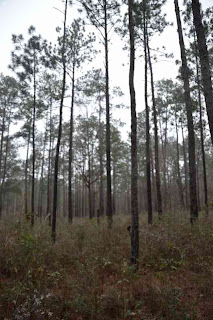On Saturday, February 25, we departed from home with light snow falling. By the time we got to Marshall, Michigan, we were tired of the constant snow and agreed that we'd waited one day too long to get out of town! By the time we reached Indianapolis, the snow had stopped and the sun was breaking out a bit. Today was mainly a travel day (nearly 700 miles driven), but a stop to refresh ourselves was in order, and that was at Muskatatuck National Wildlife Refuge in southern Indiana. Much of the wildfowl had left with the mild winter, but there were still some dabbling ducks around. Perhaps the most interesting "sighting" was hearing Spring Peepers calling...not many, just a couple, but peepers nonetheless. We stopped for the night in western Kentucky. No photo highlights from today.
Sunday, February 26 found us southbound, stopping at Reelfoot National Wildlife Refuge in northwestern Tennessee. Although we had seen Baldcypress trees in southern Indiana, they were really abundant at this refuge, making for an interesting photo and indicating out progress southward.
 |
| Reelfoot National Wildlife Refuge, Tennessee |
Other signs that we weren't in Michigan any more included abundant Carolina Wrens, and numerous Carolina Chickadees. At the spot where the photo above was taken, there were Leopard Frogs calling, and two adult Forster's Terns were flying around beyond these Baldcypresses. Another long drive today (more than 500 miles) took us to south-central Mississippi.
On Monday, February 27, we drove the southernnmost porton of the Natchez Trace Parkway in Mississippi. Many years ago, we drove this road in spring when it was much greener than today, and with many different birds. The highlight back then was a Swainson's Warbler, but there was no chance of that today. We made several stops to hike and see what natural gems we could discover.
 |
| Natchez Trace National Scenic Trail adjacent to the Natchez Trace Parkway |
We immediately noticed among the bare deciduous branches (only the conifers were green), a bright yellow flower. In Michigan, one of the earliest plants to flower is Spicebush, which has bright yellow "tufts" of flowers, and is very eyecatching. This one was even more eyecatching as the flowers were larger, and instead of a shrub, this appeared to be a vine. Eventually we were able to pull off and examine them closely. Later on in the trip, we found out that it is a native vine called Carolina Jessamine (Gelsemium sempervirens), and is one of the earliest flowers in many areas of the southern U.S.
 |
| Carolina Jessamine (Gelsemium sempervirens) |
At another stop, Rocky Springs Park along the Parkway, we found a bunch of Trilliums, many about to bloom. The mottled leaves and shape of the flowers suggest that this is Trillium cuneatum, but I will need to verify this once we get home.
 |
| Probable Trillium cuneatum in southern Mississippi. |
We did find a couple of them that were fully open and blooming.
 |
| Probable Trillium cuneatum in southern Mississippi. |
One of our missions for this part of Mississippi was to find a salamander. Any salamander. Eventually, after turning over enough logs (carefully, as rattlesnakes can hide under logs too), we found one; a Mississippi Slimy Salamander, a species we'd seen before but still another nice sign of spring.
 |
| Mississippi Slimy Salamander |
The slimy salamander species have a very sticky skin secretion that gives them their name. It makes them very slippery to hold, but the secretion dries onto the skin very quickly, reminding me of getting Super Glue onto my fingers (don't ask!). Toward the end of the drive on the Parkway, we stopped at Owens Creek, where we came across a waterfall that was nice, though a shadow of its former self, as the water table in this area has dropped 7 feet over the last 100 years.
 |
| Owens Creek waterfall, along Natchez Trace Parkway, MS |
We then headed into Louisiana, and after a fairly long drive we got into the southwestern portion of the state. A sign that we were near the Gulf Coast was the presence of Boat-tailed Grackles.
 |
| Boat-tailed Grackle, Sabine NWR, Louisiana |
A less common species in southwestern Louisiana, though increasing in recent years, is the Neotropic Cormorant, and we were happy to see several of these, including this one in high breeding plumage.
 |
| Neotropic Cormorant, Sabine NWR, Louisiana |
It was near the end of the day, however, when we had two really nice bird highlights. At one point, a Crested Caracara flew toward the road, and dove down on something in the ditch behind a row of trees. Caracaras are rare but possibly increasing in extreme southwestern Louisiana, but we'd never seen them in the state before. Then, only two miles down the road from this, a bird came flying in from the southwest. Its floppy flight, white head and breast, made me think it might be an egret, but when it got over the car its black flight feathers and deeply forked black tail were clear - a Swallow-tailed Kite! This is very early for the species in Louisiana, and after entering the sighting into eBird the state compiler asked for details of the sighting, which I happily provided. A few more miles and we were in Texas, and headed up north of Beaumont, making it more than 500 miles for the day. Now that we're in Texas, the drives can be shorter!
On Tuesday, February 28, we headed into the Big Thicket National Preserve. We have been here before, and as it is one of the last places where Ivory-billed Woodpeckers had been seen (though more than 70 years ago), it has a special aura. We had three objectives this morning, two botanical and one herpetological. A lot of East Texas is "piney woods", longleaf pine where species like Bachman's Sparrow, Red-cockaded Woodpecker, and Brown-headed Nuthatch make their homes. Only the last species made an appearance for us today.
 |
| Big Thicket National Preserve, TX |
We were still seeing Carolina Jessamine, and the naturalist at the visitor's center here helped us with the identification. It was easy since it was about the only plant flowering even here, and certainly the most conspicuous. The photo below shows its viney growth well.
 |
| Carolina Jessamine at Big Thicket Preserve, TX |
But it was two other plants that drew us here this time; a sundew and a pitcher plant - carnivores! So obviously we had to walk both the Sundew Trail and the Pitcher Plant Trail. The Sundew Trail was a nice walk, but other than giving us our first taste of how the mosquito season was progressing in Texas, we saw very little. But the Pitcher Plant Trail lived up to its name, with good numbers of them coming up. It seems odd that in such a moderate climate that these "pitchers", which are really the leaves of the plant, must re-grow each spring. If I'm not mistaken (and in the realm of botany I'm often mistaken!), the pitcher plants in Michigan retain their leaves all year. This species, Sarracenia alata, is a tall, slender one as can be seen in the photo below.
 |
| Pitcher Plant (Sarracenia alata) |
Some of them were mostly green, but others had nice orange and red veins inside the hood. Getting a photo of this was quite a challenge because the plants were only about 8-inches tall, and the boardwalk was a good 18-inches above the ground. Leaning over and downward to get the photo below required skills that would have impressed members of Cirque de Soleil...
 |
| Pitcher Plant (Sarracenia alata) |
Try as we might, we could not locate any sundews. But we did get lucky with our salamander, this one a lifer; Dwarf Salamander.
 |
| Dwarf Salamander (Eurycea quadridigitata) |
From here we headed southward to the Anahuac National Wildlife Refuge. The last time we were here, in 1988, there were only a couple dikes that could be driven. The area was much improved for birder access. The weather was not in our favor though, as fog had been present all day today and was particularly dense here close to the Gulf coast. We could hear Snow Geese calling out in the distance but couldn't see them; then all of a sudden a flock of 100 would fly over the road out of the fog. The mosquitos were also TERRIBLE. Clouds of them. It was about 70 degrees, but we had to keep the windows rolled up most of the time so that we didn't get car-jacked by these voracious hordes. I did manage a photo of another nice Neotropic Cormorant.
 |
| Neotropic Cormorant at Anahuac NWR, TX |
Tomorrow (March 2) we'll be arriving in the Rio Grande Valley where there should be plenty of birds, flowers, butterflies, and dragonflies. In a few days, I'll post about the past couple days we spent along the Central Texas coastline.



No comments:
Post a Comment